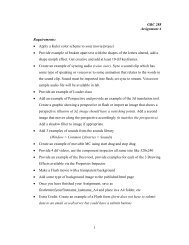Introducing Financial Accounting - CCSN Computer Graphics Program
Introducing Financial Accounting - CCSN Computer Graphics Program
Introducing Financial Accounting - CCSN Computer Graphics Program
You also want an ePaper? Increase the reach of your titles
YUMPU automatically turns print PDFs into web optimized ePapers that Google loves.
wiL27041_ch01_002-047.indd Page 9 10/4/10 7:12:23 PM user-f499 /Volumes/204/MHBR211/wiL27041_disk1of1/0073527041/wiL27041_pagefiles<br />
Chapter 1 <strong>Introducing</strong> <strong>Financial</strong> <strong>Accounting</strong> 9<br />
GAAP aims to make information in financial statements relevant, reliable, and comparable.<br />
Relevant information affects the decisions of its users. Reliable information is trusted by users.<br />
Comparable information is helpful in contrasting organizations.<br />
In the United States, the Securities and Exchange Commission (SEC), a government<br />
agency, has the legal authority to set GAAP. The SEC also oversees proper use of GAAP by<br />
companies that raise money from the public through issuances of their stock and debt. Those<br />
companies that issue their stock on U.S. exchanges include both U.S. SEC registrants (companies<br />
incorporated in the United States) and non-U.S. SEC registrants (companies incorporated<br />
under non-U.S. laws). The SEC has largely delegated the task of setting U.S. GAAP to the<br />
<strong>Financial</strong> <strong>Accounting</strong> Standards Board (FASB), which is a private-sector group that sets both<br />
broad and specific principles.<br />
International Standards<br />
In today’s global economy, there is increased demand by external users for comparability in accounting<br />
reports. This demand often arises when companies wish to raise money from lenders<br />
and investors in different countries. To that end, the International <strong>Accounting</strong> Standards Board<br />
(IASB), an independent group (consisting of individuals from many countries), issues International<br />
<strong>Financial</strong> Reporting Standards (IFRS) that identify preferred accounting practices.<br />
If standards are harmonized, one company can potentially use a single set of financial statements<br />
in all financial markets. Differences between U.S. GAAP and IFRS are slowly fading as<br />
the FASB and IASB pursue a convergence process aimed to achieve a single set of accounting<br />
standards for global use. More than 115 countries now require or permit companies to prepare<br />
financial reports following IFRS. Further, non-U.S. SEC registrants can use IFRS in financial<br />
reports filed with the SEC (with no reconciliation to U.S. GAAP). This means there are two sets<br />
of accepted accounting principles in the United States: (1) U.S. GAAP for U.S. SEC registrants<br />
and (2) either IFRS or U.S. GAAP for non-U.S. SEC registrants.<br />
The convergence process continues and, in late 2008, the SEC set a roadmap for use of IFRS by<br />
publicly traded U.S. companies. This roadmap proposes that large U.S. companies adopt IFRS by<br />
2014, with midsize and small companies following in 2015 and 2016, respectively. Early adoption<br />
is permitted for large multinationals that meet certain criteria. For updates on this roadmap, we can<br />
check with the AICPA (IFRS.com), FASB (FASB.org), and IASB (IASB.org.uk).<br />
IFRS<br />
Like the FASB, the IASB uses a conceptual framework to aid in revising or drafting new standards. However,<br />
unlike the FASB, the IASB’s conceptual framework is used as a reference when specific guidance is lacking.<br />
The IASB also requires that transactions be accounted for according to their substance (not only their<br />
legal form), and that financial statements give a fair presentation, whereas the FASB narrows that scope<br />
to fair presentation in accordance with U.S. GAAP. ■<br />
Conceptual Framework and Convergence<br />
The FASB and IASB are attempting to converge and enhance the conceptual framework that<br />
guides standard setting. The framework consists broadly of the following:<br />
● Objectives—to provide information useful<br />
to investors, creditors, and others.<br />
● Qualitative Characteristics—to require<br />
information that is relevant, reliable, and<br />
comparable.<br />
● Elements—to define items that financial<br />
statements can contain.<br />
● Recognition and Measurement—to set<br />
criteria that an item must meet for it to be<br />
recognized as an element; and how to measure<br />
that element.<br />
Objectives<br />
of financial accounting<br />
Qualitative<br />
characteristics<br />
Elements<br />
Recognition and measurement<br />
C4<br />
Explain generally accepted<br />
accounting principles and<br />
define and apply several<br />
accounting principles.<br />
Point: State ethics codes require<br />
CPAs who audit financial statements to<br />
disclose areas where those statements<br />
fail to comply with GAAP. If CPAs fail<br />
to report noncompliance, they can lose<br />
their licenses and be subject to criminal<br />
and civil actions and fines.









